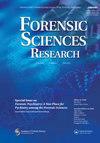Haemorrhagic Artefacts Produced by Ant Activity on Human Cadavers in the Early Post-Mortem Period
IF 1.8
4区 医学
Q3 MEDICINE, LEGAL
引用次数: 0
Abstract
Forensic entomology is primarily focused on using carrion blow flies and beetles (Diptera and Coleoptera) to estimate the time since death. However, insect artefacts, such as footprints, defecations, regurgitations, and splatters are also considered within the disciplines of bloodstain pattern analysis (BPA), and ants (Hymenoptera: Formicidae) have been studied in forensic pathology for their potential to alter bodies. Although ant activity has been mostly reported as “dry marks” (abrasions) on decomposing bodies, their colonisation of congested or hypostatic anatomical regions can produce alterations that mimic active or recent haemorrhages. Therefore, if a body exhibits external haemorrhage/s without any apparent origin, artefacts caused by insects, such as ants, should be considered. This study describes ten cases of post-mortem ant activity observed in the Andaman and Nicobar Islands (India), and analyses the resulting external haemorrhagic artefacts, which exhibit different patterns of morphology, distribution, and location. The study proposes a classification system to aid in identifying bloodstain patterns caused by ant activity, assisting in determining the mechanism/s of the lesions, the original position of the body, and any subsequent interactions with the surrounding environment. Ultimately, this classification can improve the accuracy of reconstructing the events that occurred during the early post-mortem period, as well as the circumstances surrounding death.早期人类尸体上蚂蚁活动产生的出血人工制品
法医昆虫学主要集中在使用腐肉苍蝇和甲虫(双翅目和鞘翅目)来估计死亡时间。然而,昆虫的人工制品,如脚印、排便、反刍和飞溅物也被认为是血迹模式分析(BPA)的学科,而蚂蚁(膜翅目:蚁科)在法医病理学中也被研究过,因为它们有可能改变身体。虽然蚂蚁的活动大多被报道为腐烂尸体上的“干痕”(磨损),但它们在充血或实体解剖区域的殖民化可以产生类似活动性或近期出血的改变。因此,如果身体出现没有任何明显来源的外部出血,则应考虑由昆虫(如蚂蚁)引起的人工制品。本研究描述了在安达曼和尼科巴群岛(印度)观察到的10例死后蚂蚁活动,并分析了由此产生的外部出血人工制品,这些人工制品表现出不同的形态、分布和位置模式。该研究提出了一种分类系统,以帮助识别由蚂蚁活动引起的血迹模式,协助确定病变的机制、身体的原始位置以及随后与周围环境的任何相互作用。最终,这种分类可以提高重建死后早期发生的事件以及死亡周围环境的准确性。
本文章由计算机程序翻译,如有差异,请以英文原文为准。
求助全文
约1分钟内获得全文
求助全文

 求助内容:
求助内容: 应助结果提醒方式:
应助结果提醒方式:


